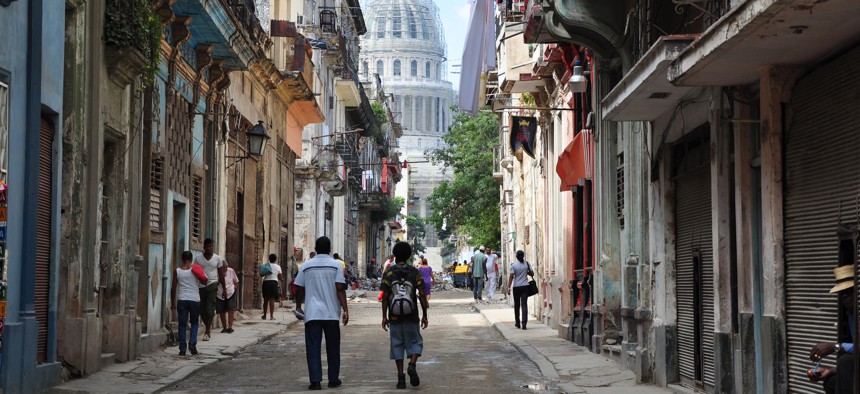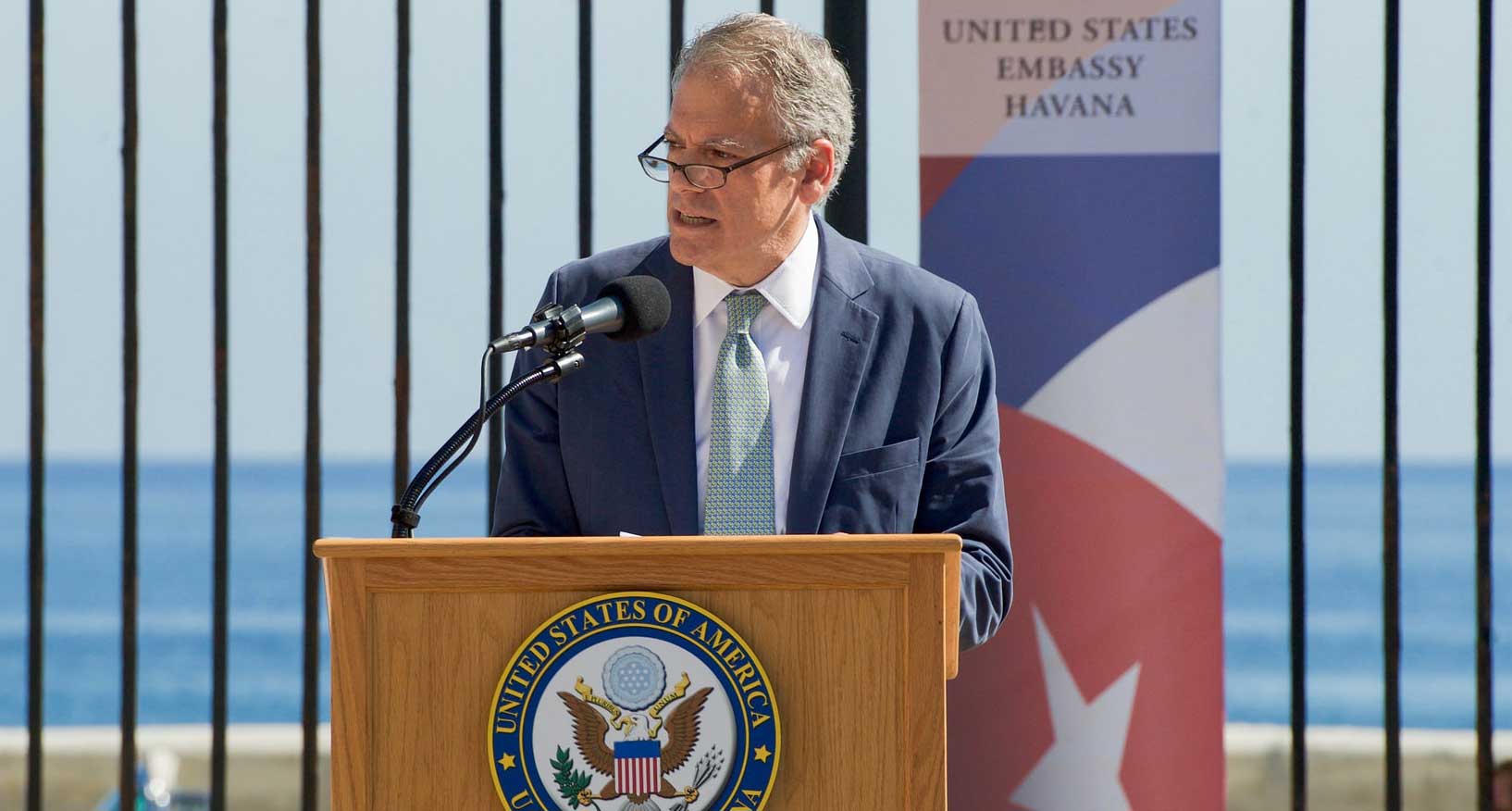
Havana Flickr user halbag
Cuba Diary: Inside the American Diplomatic Effort
A visit with Jeffrey DeLaurentis, who is leading the hard work of restoring U.S.-Cuba relations.
HAVANA--When the United States moved in 2014 to improve relations with communist Cuba, the State Department turned to a longtime Senior Foreign Service Officer, Jeffrey DeLaurentis, to represent American interests in Havana.
On a visit to Cuba last month, I sat down with DeLaurentis, seeking to understand the work he and others have done to facilitate resumption of formal diplomatic relations for the first time since 1959.
By the time of my visit in January, the two countries had reestablished their embassies, but it was clear that much more work would be needed before full relations could be restored. Cuba, for example, wants the United States to lift its ongoing embargo on trade and tourism and to return the U.S. naval base in Guantanamo. The American government insists that the Cuban regime grant more freedom to its citizens.

I wanted to learn from DeLaurentis about the work preceding formal opening of our embassy on Aug. 14, and about next steps toward normalizing relations.
During my eight-day “people-to-people” visit with a group organized by Tufts University, I also sought to understand the Cuban revolutionary system and the current social and economic structures.
In the Embassy
The U.S. embassy has a forbidding mien, although when it was built in 1953 it was much admired by the architectural press. Its original travertine facing is long gone, replaced by gray granite. Tall metal security fencing protects its entrance. But, as Architect magazine observed in 2014, it remains a “functioning relic of Washington's postwar bid to use modern architecture to project its image as a triumphant, dynamic superpower.”
Abandoned in 1959, the building was reopened in 1977 as a “special interest section” under the aegis of the Swiss government. In 2006, the State Department mounted a Times-Square-style news ticker high up on the embassy’s facade to broadcast news and human rights messages in Spanish. Cuba’s then-president, Fidel Castro, reacted sharply to the move, renaming the area in front of the building “Anti-Imperialist Plaza” and installing a forest of tall flagpoles carrying black flags to block views of the billboard.
From inside the embassy’s tall gates, I snapped a picture of the towering flagpoles--123 of them, according to the Marine guards. Now, with relations easing, only a single Cuban flag flies in the rusting forest. Gone too is the large billboard the Cubans erected in 2007 depicting then-President George W. Bush as “El Asesino,” or the Assassin. And the lobby was decorated with work of Cubans who won an embassy-sponsored poetry and photo contest whose announcement last April was one small step toward better relations.

In the ambassadorial suite on the seventh floor, I asked DeLaurentis about the challenges of establishing a traditional embassy in this hot spot of Cold War tensions.
DeLaurentis has been in the Foreign Service since 1991, and served two tours in Havana before his current assignment began in 2014. He was confirmed by the Senate for an earlier posting at the United Nations, but stepped down from ambassadorial rank to take on the Cuba challenge as chargé d’affaires in Havana. The Obama administration, conscious of Republican opposition in Congress and among GOP presidential contenders to the thaw in bilateral relations, has not sent the Senate a nominee for confirmation to the post.
As we talked in his office, which looks down on the Malecón seawall promenade toward Old Havana, DeLaurentis said lack of Senate confirmation wasn’t slowing him down. He tries to be “ubiquitous” in Havana, he said, showing the flag at social, cultural, diplomatic and other events, and meeting with ever more frequent delegations of Americans interested in Cuba’s future.
Two Tracks
DeLaurentis said the embassy’s work was proceeding on two tracks: working with Washington colleagues in the overall effort to reestablish relationships after more than five decades of hostility, and working to create an embassy with sufficient staff and capabilities to administer evolving U.S. policies.
The thaw began on Dec. 17, 2014, when President Obama announced from the White House that he would pursue reestablishing diplomatic relations with Cuba in the wake of a prisoner exchange. DeLaurentis, already in charge in Havana, would spend the next six months focusing on steps that would have to precede the formal opening of embassies in the two capitals. The process remained contentious at home. When, for example, the Obama administration met one of Cuba’s demands by removing it from a list of state sponsors of terrorism on May 29, 2015, GOP leaders denounced the move.
DeLaurentis said Cuba had wanted assurances about the behavior of U.S. diplomats as they maintained their contacts with civilian society--alluding to Cuban suspicions that the American government had been encouraging active dissent.
The United States had its own list of issues to be resolved--some of which would be handled routinely with any other country. Importantly, said DeLaurentis, the embassy needs to augment its 40-person diplomatic staff. The count does not include Marine guards or Cuban nationals who perform maintenance duties in the embassy compound.
U.S. officials wanted the embassy to be more accessible to visitors--Cubans and others. They demanded that the phalanx of Cuban guards ringing the embassy be removed. When I arrived, a small group of people were queued at one entrance, and no Cuban guards were in evidence.
The embassy needed supplies from the United States, including some in secure containers that would not be opened for inspection. And American officials wanted their diplomats to be free to travel in Cuba without first securing permission from the government.
Adding staff is critical, DeLaurentis said, because of the rapid growth in the number of of Americans visiting the island. He’s hoping to expand citizen services and public affairs staffs to handle “many, more educational and cultural exchanges.” Most trips are for “purposeful travel,” such as tour on which I traveled to the country. Artists and entertainers are showing up in increasing numbers too: As The Wall Street Journal observed in a Jan. 29 article headlined “The American Invasion of Cuba,” “culture always moves faster than government.”
The embassy has facilitated visits by three Obama Cabinet members, the deputy secretary of the Homeland Security Department, and various State Department officials. Four governors have visited since relations were relaxed. While we were there, Virginia Gov. Terry McAuliffe was traveling in the country with a delegation of about 20 business executives.
Commercial links remain difficult, because the U.S embargo instituted in 1960 remains largely in place. In Havana, McAuliffe’s delegation concluded a deal for cooperation between the Port of Virginia and Cuba’s big, newly developed, mega-port in Mariel, in the hope of boosting trade when political conditions allow.
The evening before my visit, DeLaurentis had welcomed the Virginia delegation with a reception at the elegant U.S. residence in the upscale Miramar neighborhood of Havana. The neoclassical limestone building, built in 1941, contains 65 rooms, including spacious, elegant chambers for receptions on July 4th and other occasions. Many ambassadors are wealthy political donors, but DeLaurentis is not one of them. He observes with a grin that the building’s grandeur notwithstanding, he must “stay within the budget” for parties there.
Long and Complicated
DeLaurentis and his colleagues are rowing against the tides of a half-century of history.
At the Summit of the Americas in Panama in April 2015, Cuban President Raul Castro told Obama: “No one should entertain illusions. It is true that we have many differences. Our countries have a long and complicated history…. We are willing to discuss everything, but we need to be patient--very patient.”
As we traveled, the Cuban socialist/communist system seemed deeply entrenched. Huge billboards along the roads celebrated the revolution. “La Revolución Seguirá Andelante” (“The Revolution Advances”), announced one huge billboard along a road. “Todo por la Revolución” (“Everyone is for the Revolution”), said another. Some 95 percent of adult Cubans belong to the Committee for the Defense of the Revolution.
We learned that people subsist on minimal incomes, but are guaranteed free health care, rationed food supplies and free education. Cubans also are promised lifelong employment--though the government in effect fired about 1 million people a few years back, and DeLaurentis estimates about a quarter of the workforce is in the “non-state sector.” The government says unemployment is extremely low--roughly 2 percent--but it’s evident that many are underemployed.

In Santa Clara, we visited a school for artists, part of a network of meritocratic education that chooses children to advance in callings according to their ability. Our visit included performances by children aged 10 to 14 in ballet, folk dancing, instrumental music and singing. The best of them would be sent on for advanced training. The most talented could expect to perform in the nation’s capital, but even those who do not make it that far can expect steady employment entertaining the people of their towns.
Children without special talents are sent to technical schools. But Cuba makes a big effort to identify students who can be trained in medicine and other professions to serve not only its own population but other countries.
Exporting Talent
Venezuela has been an important export market for Cuban doctors, nurses and other professionals, whose services are exchanged for cheap oil, food and other goods. Newly minted graduates owe the state a two-year stint of service, and are given little compensation. Once they have met their obligation, some professionals choose to go abroad for two-year commitments that can earn many times the salaries that they would get at home. Our guide gave us the example of his sister: she is teaching economics in Guinea, and is paid $1,000 a month. Half of that is remitted to the Cuban government, but her remaining share is many times the salary she’d be paid at home.
So, while countries from Russia to France to the United States emphasize export of airplanes, weapons, machinery and other expensively manufactured items, Cuba exports its human capital. More than 50,000 Cuban medical workers are deployed in 66 nations around the world, according to the Medical Daily newsletter.
The average government salary is about $25 a month. Entry-level nurses earn about $24 a month, while top-performing doctors bring home up to $67. There’s a powerful incentive to get into the tourism industry, where tips can make a real difference in living standards. Our guide works for a state-owned tourism bureau, but at the end of the trip we gave him (and also our bus driver) more than $500 as a gratuity. A friend reports that his group gave its Cuban guide $1,400 as a tip for a week’s work.
Many of the hotels are owned by a branch of the military run by the little-known son-in-law of Raul Castro, Gen. Luis Alberto Rodriguez. The arrangement provides a significant amount of revenue for the government--and good jobs for retiring military officers.
Social services seemed well-organized and humane, as we observed during visits to a senior center and a facility for people afflicted with Down Syndrome. Of course, we were likely being shown only the best.
On a walking tour of Old Havana, an architect working for the government’s restoration agency showed us progress in renovating this part of the city’s crumbling housing stock. Apartments in pre-revolution buildings are now often occupied by three generations, a reflection of the shortage of housing in and around Havana. In their high-ceilinged ground floors, many families have created a second living space by erecting a platform halfway up the wall, on which one of the generations lives. With no windows and no ventilation, these ersatz dwellings have become known colloquially as “barbecues.”
The architect talks of how difficult it is to renovate such buildings, in part because the families don’t want to move to temporary housing with little prospect of returning to their longtime neighborhoods. Renovation, of course, entails removal of the barbecues. Despite the difficulties, about a third of Old Havana has been renovated.
The housing we’re shown is better than much of the stock elsewhere in Havana. Bill Thompson, a veteran journalist and photographer, later walked five miles from Old Havana back to our hotel through the roads a few blocks back from the oceanfront, and reported that conditions resembled Beirut, with crumbling buildings and crazily strung electrical wires. That confirmed the warning our our Frommer’s Cuba guidebook conveyed: Watch for falling stones.
Decent housing is only one of many problems challenging the Cuban people. The economy is hampered by a dual-currency system, a lack of investment, and state regulations that stand in the way of robust private enterprise. By world standards, Cuba isn’t truly poor, and it gets good marks on human development indexes. But economic conditions won’t improve much until the United States lifts its embargo and tourism takes off--a development not foreseen until 2017 at the earliest.
In anticipation of many more visitors, the Cuban government is renovating the old port of Havana to receive more cruise ships that ply the Caribbean. And Carnival has announced a spring cruise to the country. But it’s far from clear that Havana has the infrastructure--in transportation and hotels, for example--to handle a tourism boom.
Better Economy, More Freedom?
DeLaurentis is toiling to create conditions that might set the stage for lifting the embargo. He ticks off deals that have been completed or are on their way: a civil aviation agreement, resumption of postal services between the two nations, two environmental protection agreements and a deal to coordinate efforts to combat the narcotics trade. Among his 2016 objectives: to make sure these policy advances “become irreversible.”
On Jan. 26, the Obama administration announced new regulations allowing financing of authorized exports and re-exports to Cuba. Agricultural products are excluded, but the regulations allow export of important agricultural inputs such as pesticides, fertilizers and farm equipment. We’d seen the need for those in our travels, visiting a farm in Pinar del Rio province that was “organic” (and small) chiefly because it had no access to such inputs. Ancient but still functioning farm machinery imported from the communist bloc is found almost exclusively on state-owned farms.

U.S. exports also will be allowed for products used to improve public transportation--which remains a fascinating hodgepodge in Havana and the countryside. In the capital, the fabled 1950s-era American cars are a genuine phenomenon. Many are immaculately kept, though now mostly powered by replacement diesel engines. Others are truly original: my wife and I took a ride in a bright pink 1940 Chevrolet convertible with its original gas engine.
People also ride in Russian Lada cars, other low-end imports, aging buses, pedicabs, and--especially in provincial cities like Santa Clara--horse-drawn vehicles with two benches allowing six or eight people to sit facing one another. There’s a fleet of tourist buses like the one we used, made in China.
DeLaurentis has helped establish a bilateral commission and other working groups to deal with thorny issues, such as human rights and property restitution. U.S. claims for properties seized during the revolution, originally valued at $1.8 billion, now total $7 billion, factoring in a half-century of interest. Cuba has counterclaimed for $117 billion in damages resulting from the embargo and the CIA’s secret paramilitary war against the Castro regime in the 1960s.
The embargo has continued as the Cuban communist regime has fomented trouble around the world, from the missile crisis of 1962 to the war in Angola against South African forces and CIA-backed rebels. The regime isn’t exporting revolution as it once did under such leaders as Ernesto “Ché” Guevara, removing one obstacle to better relations.
But freedom remains a huge issue, especially for the huge Cuban diaspora concentrated in Miami. Cuban expatriates follow the reporting of Havana-based Yoani Sanchez, whose Generación Y blog captures the small indignities and the lack of freedom that characterize everyday life on the island. A recent post laments that “one-sided state journalism continues to be a long way from objectivity and respect for the truth.”
DeLaurentis emphasized that the United States is working to secure increased freedom for the Cuban people. U.S. telephone companies Verizon and Sprint have recently signed deals with the Cuban monopoly telecommunications provider ETECSA, promising easier international calling. Since mid-2013, Cubans have been able to sign on to the Internet at 118 centers across the country, but at a rate of $2.00 an hour, an expensive proposition given that state salaries average around $20 per month. Phones, tablets and computers are beyond the reach of many. Still, DeLaurentis said the goal is to extend Internet access to half the population by 2020.
Although relations are thawing, most Cubans have seen little improvement in their daily lives. And many fear that the United States will end its longstanding “wet foot, dry foot” policy granting legal residency to Cubans who manage to reach land in the United States. Even though the policy is codified in a 1995 law the Obama administration is not presently proposing to amend, the fear has induced a new exodus in recent months. Some 40,000 Cubans have attempted a dangerous journey through Central America to reach the southern border of the United States. DeLaurentis responds to my question about reasons for the exodus by saying simply that emigrants are “looking for better opportunities elsewhere.” He adds: “We want legal and orderly immigration.”
The ultimate hope, both in Havana and Washington, is that Cuban life will improve enough to induce ambitious and restless young citizens to remain in their country. But the evidence suggests its fulfillment may be a long time coming.
Top photo: Flickr user halbag






